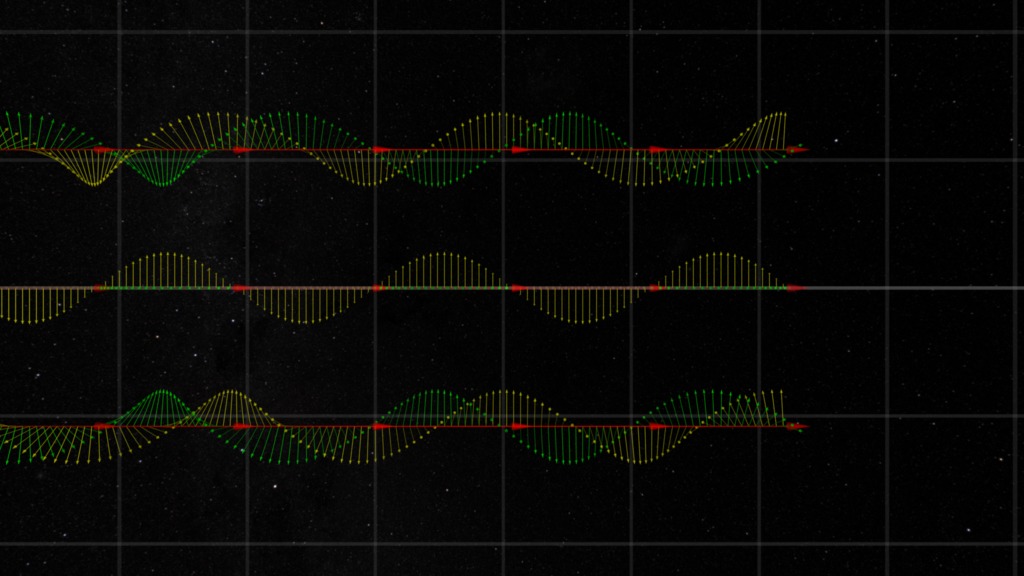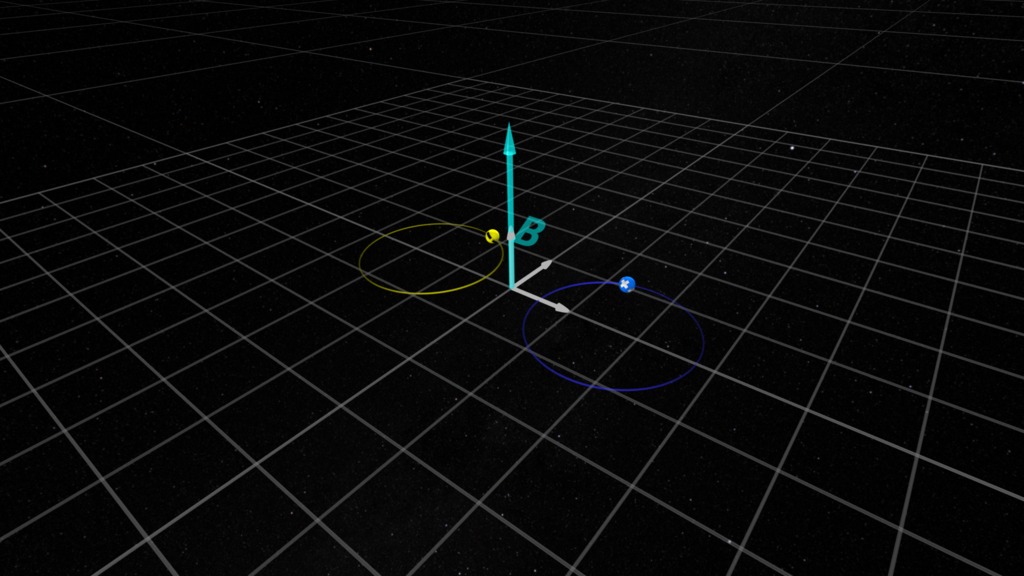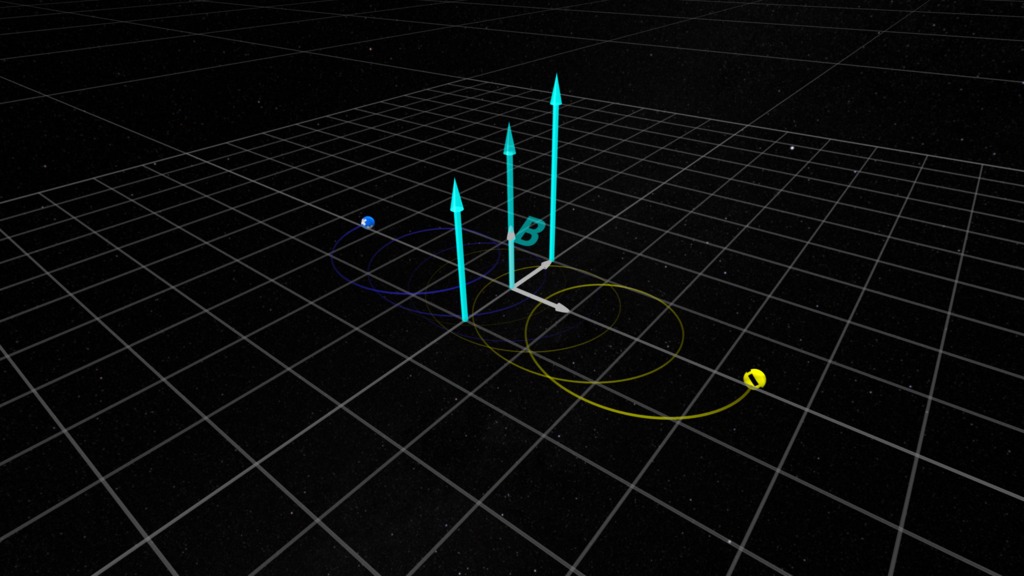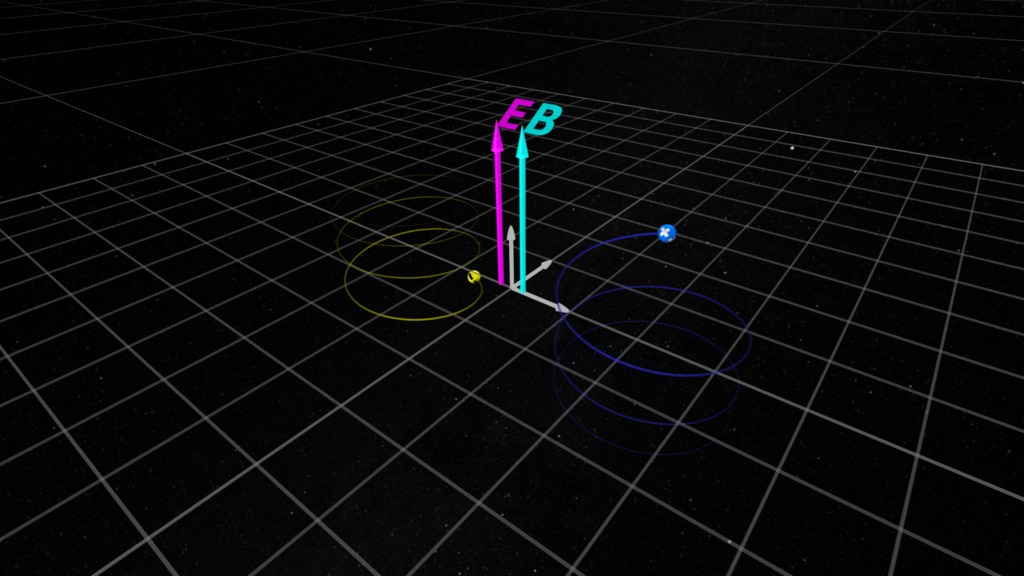Plasma Zoo: E-cross-B Drift
Visualization from two camera positions of gyro-motion of charged particles in perpendicular electric and magnetic fields.
Motions of charged particles in electromagnetic fields are important in understanding the behaviors of plasmas in space. In Plasma Zoo, we present visualizations of particle motions in simple electromagnetic field configurations.
One of the more fundamental motions of charged particles in a magnetic field is gyro-motion, or cyclotron motion. If a charged particle is moving in a magnetic field, the particle experiences a force perpendicular to the direction of the charge motion and the field. This direction is determined by the Right-Hand Rule (Wikipedia). The resulting forcedirects the motion in a curve such that if we view along the direction the magnetic field is pointing, we will see the positive particles gyrate anti-clockwise while the negative particles gyrate clockwise.
In the previous examples (Plasma Zoo: Gyromotion in Two Dimensions, Plasma Zoo: Gyromotion in Three Dimensions and Plasma Zoo: Particle Drift in a Magnetic Gradient) we examined the motion of charged particles exclusively in magnetic fields, represented by cyan arrows and the letter 'B'.
In this example, like Plasma Zoo: Field-Aligned Current (Birkeland Current), we include a constant electric field, designated by a magenta arrow and the letter 'E', but this time it will point in a direction at right angles (perpendicular) to the magnetic field.
We again include two charged particles of the same mass and speed and with positive ('+') and negative ('-') charge. As in the examples before, the charged particles are directed into circular motions (gyro-motion) by the magnetic field, moving around the circular path in opposite directions. If we view along the direction the magnetic field is pointing, we will see that the positive particles gyrate anti-clockwise while the negative particles gyrate clockwise.
But this time, the perpedicular electric field creates an effect that is counter-intuitive. While you might expect the positive particles to drift in the direction of the electric field, and the negative particles to drift opposite the electric field direction, in fact, the positive and negative particles drift in a direction perpendicular to the electric and magnetic field directions! This is called E-cross-B drift, sometimes written ExB drift from the mathematical notation.
To understand why this is, consider just the motion of the positive particle. As the particle accelerates in the electric field, the magnetic field starts directing the particle in a curved path. The faster the particle, the larger the radius of the curved path. Eventually, the curving of the path redirects the positive particle so it is moving in a direction opposite the electric field. Through this region, the electric field acts to slow down the particle, and the curvature of the path gets smaller. The net effect of these competing motions is a net motion perpendicular to the fields. The negative particle is accelerated in the opposite sense by the electric field, which gives a net motion in the same direction.
This configuration also has the interesting effect that a neutral plasma moving perpendicular to a magnetic field, will induce an electric field perpendicular to both the magnetic field and the plasma motion. This electric field is important in the motion of the solar wind.
Important Note: The example here shows particles with the same speed and mass. If the masses are different (for example, a positive proton has about 1836 times more mass than an electron), the radius of the gyromotion will be proportionally larger for the same speed.
Credits
Please give credit for this item to:
NASA's Scientific Visualization Studio
-
Animator
- Tom Bridgman (Global Science and Technology, Inc.)
-
Project support
- Laurence Schuler (ADNET Systems, Inc.)
- Ian Jones (ADNET Systems, Inc.)
-
Scientists
- David G. Sibeck (NASA/GSFC)
- Thomas Moore (NASA/GSFC)
Release date
This page was originally published on Monday, February 2, 2015.
This page was last updated on Wednesday, May 3, 2023 at 1:50 PM EDT.
Series
This page can be found in the following series:Datasets used
-
ParticleSimulator
ID: 846
Note: While we identify the data sets used on this page, we do not store any further details, nor the data sets themselves on our site.





